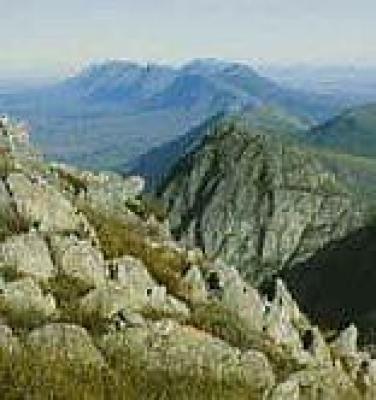Boosmansbos Wilderness Area, 267 km east of Cape Town between Swellendam and Heidelberg in the Langeberg range, is a large, rugged forest reserve that is not very well known to the general public.
It is an excellent place for hikers to clamber up peaks with far-reaching views, explore one of the larger remaining indigenous Cape forest patches in the fynbos ecological zone (it has never been exploited on a large scale), and enjoy the many flowering species which blanket the mountain slopes.
The 70 km trail of footpaths and gravel roads offers overnight huts which are simple shelters with no facilities, except for water from a nearby stream. Alternatively, hikers may sleep in the open.
The main attractions are the indigenous kloof forests and Cape fynbos in a dramatic mountain terrain. The maximum allowable size of a hiking group is 12 and the minimum is 2. Boosmansbos borders on the winter and all-year rainfall areas.
Enter here and you wil be amongst fynbos, mountains and forested ravines with indigenous trees, a variety of birds. The aim of a wilderness experience is to find no sign of humans, not even the lights of a farm. You are encouraged to keep off the beaten track. To achieve this, you have to be self-sufficient. Not even fires are permitted.
Hikers can walk to Helderfontein hut, an old stone 'management' hut, ascending via Bobbejaanskloof (14 km), and can descend via Saagkuilkloof (13 km) en route. For a longer and more fascinating altemative to the Saagkuilkloof path described, try the Grootberg-Horingberg path, probably one of the most scenically dramatic in the Cape folded mountains. Approximately 30 km long, it ascends from Helderfontein hut on the north-facing slope of Grootberg, whose highest point is at 1 637 m, traverses the mountains in a southerly direction, affording views of rich kloof forests below, and descends the south-facing slope of Horingberg in a series of zig-zags. Not often used, the path is indistinct and steep in places. Hikers should be prepared to sleep in the open.
The forest of Boosmansbos is one of the larger relics of indigenous kloof forest within Cape montane fynbos. Located on the slopes of Grootberg, it contains impressive specimens of stinkwood, yellowwood, Cape holly, white alder (witels), red alder (rooiels), beech and candlewood. A patch of mountain cypress (one of the few indigenous softwoods in South Africa) grows on an adjoining ridge.
The descent into the deep ravines is steep but worthwhile. Once under the forest canopy, you are enveloped by a completely different atmosphere to that on the fynbos-covered slopes. The forests are dark, cool and moist, providing ideal cover for bushbuck. Two uncommon birds recently recorded here are the Knysna woodpecker and the martial eagle.
On the slopes of the reserve, proteas abound and Leucadendron pubibracteolatum occurs in the vleis. Baboon and dassies are frequently seen, and keen observers may also spot grey rhebok, klipspringer and grysbok. This is the habitat of birds such as the Cape bulbul, doublecollared sunbird and redwinged starling.
The existing footpaths and tracks were originally constructed for patrol purposes; be prepared to leave the main routes and walk in the veld to reach some of the interesting peaks, forests and kloofs.


